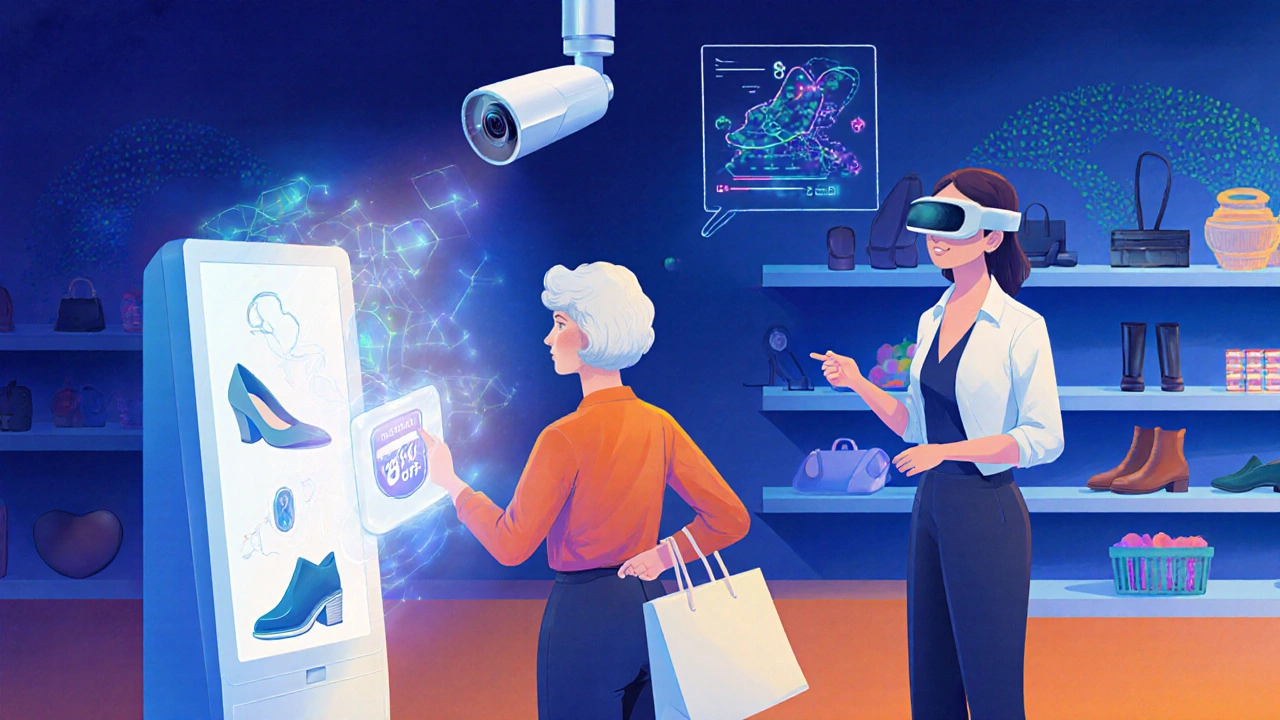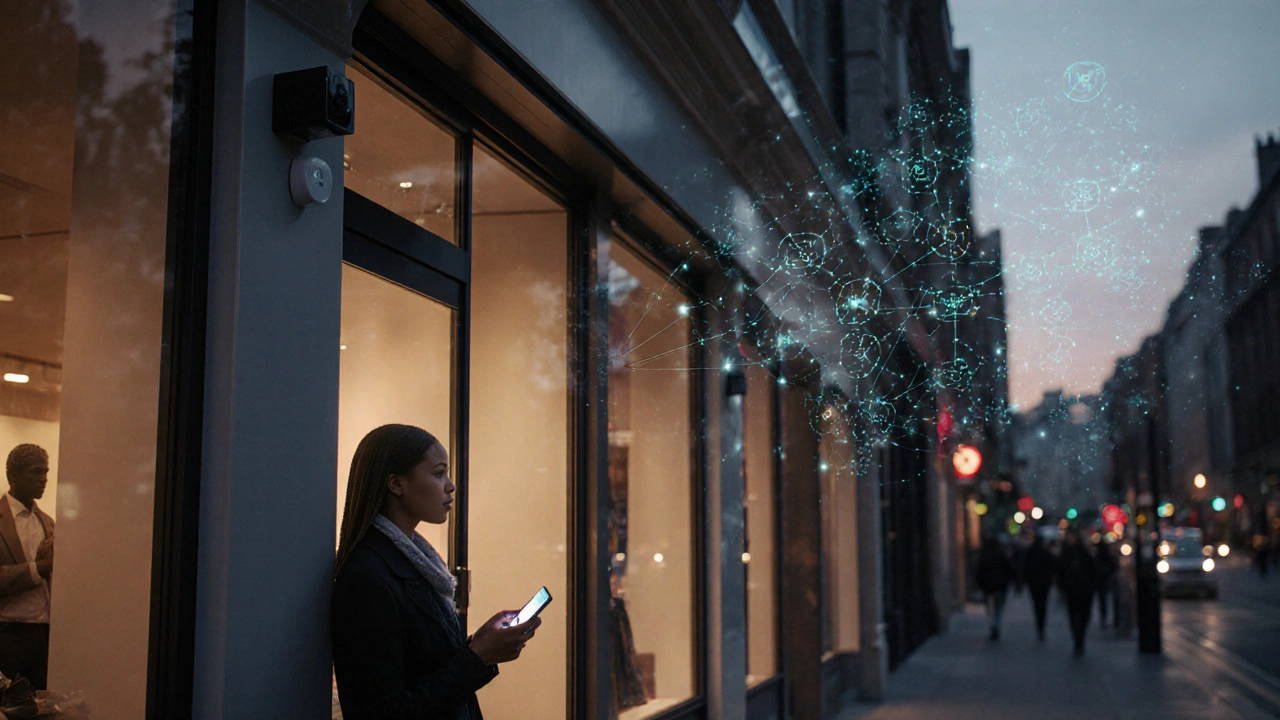Retail AI Impact Calculator
Select AI Applications to Implement
Projected Impact Summary
Enter your details and click "Calculate" to see projected benefits of AI implementation.
Retail is no longer just about shelves and salespeople. Artificial Intelligence a set of computational techniques that enable machines to mimic human decision‑making is rewriting the rules of how stores attract, serve, and keep customers.
Why the Retail Landscape Is Shifting Fast
Online giants have spent the last decade perfecting data‑driven experiences. Brick‑and‑mortar shops now face a choice: cling to the old model or adopt AI retail tools that level the playing field. The payoff shows up in higher basket sizes, shorter checkout lines, and inventory that rarely sits idle.
AI‑Powered Customer Experience
When a shopper steps inside, cameras, beacons, and mobile apps feed real‑time signals to an AI engine. The system instantly predicts what the person might need, nudging staff or digital displays with relevant offers.
- Personalization the tailoring of product recommendations and promotions based on individual behavior lifts average order value by 10‑15% in most pilot programs.
- Recommendation Engine an algorithm that suggests items using collaborative filtering and deep learning can increase conversion rates up to 25% when integrated into both web and in‑store kiosks.
Brands such as Sephora and Nike already run in‑store AI consoles that scan a customer’s loyalty profile, then surface complementary products within seconds.
Inventory Management Gets Smarter
Out‑of‑stock situations cost retailers roughly 8% of annual revenue. AI changes that by forecasting demand with granular precision.
- Demand Forecasting predictive models that analyze sales history, weather, promotions, and local events reduce forecast error from 20% to under 5% in leading supermarkets.
- Supply Chain Optimization the use of AI to allocate stock across distribution centers and stores cuts logistics costs by 12% on average.
Walmart’s AI‑driven replenishment system now triggers automatic reorder points for 70% of its SKU base, shaving weeks off the restocking cycle.
Computer Vision: Seeing What Humans Miss
Imagine a camera that not only counts foot traffic but also detects product placement errors, shopper dwell time, and even sentiment.
- Computer Vision image‑processing algorithms that interpret visual data from cameras and sensors enables loss‑prevention analytics and real‑time shelf‑stock alerts.
- Heat‑map dashboards built on vision data reveal that 35% of shoppers never glance at the top shelf in aisles, prompting retailers to relocate premium items.
Retailers like Zara use vision‑based checkout, allowing customers to walk out with items while the system automatically charges their account.
Chatbots and Virtual Assistants on the Floor
AI‑driven conversational agents are no longer limited to website help desks. In‑store kiosks and mobile voice assistants guide shoppers through product catalogs, check inventory, or even suggest outfit pairings.
- Chatbot an automated program that interacts with users via text or voice to answer queries reduces average handling time by 40% compared with human agents.
- H&M’s virtual stylist, powered by natural‑language processing, handles 1.2million style queries per month with a 92% satisfaction score.

Quick Comparison of Core AI Use Cases
| Use Case | Primary Benefit | Typical ROI Timeline | Key Technology |
|---|---|---|---|
| Personalization & Recommendation | Higher basket size & repeat visits | 3‑6months | Deep learning, collaborative filtering |
| Demand Forecasting | Reduced stockouts & overstock | 6‑12months | Time‑series models, gradient boosting |
| Computer Vision Analytics | Improved store layout & loss prevention | 4‑8months | Convolutional neural networks |
| Chatbots & Virtual Assistants | Faster service & labor savings | 2‑4months | Natural language processing |
Challenges Retailers Must Tackle
Adopting AI isn’t a plug‑and‑play switch. Below are the most common hurdles and how to address them.
- Data Silos: Store, e‑commerce, and supply‑chain data often live in separate systems. A unified data lake or cloud warehouse is the first step.
- Bias in Algorithms: If training data reflects past inequities, recommendations can unfairly favor or ignore groups. Regular audits and diverse data sources keep models fair.
- Privacy Regulations: GDPR, CCPA, and emerging AI‑specific rules demand transparent data usage. Implement consent‑driven collection and anonymization pipelines.
- Talent Gap: Few retail teams have in‑house ML expertise. Partnering with AI vendors or upskilling staff through bootcamps narrows the gap.
Best‑Practice Checklist for a Smooth AI Rollout
- Start with a pilot that solves a clear pain point (e.g., out‑of‑stock alerts).
- Define success metrics up front - conversion lift, inventory turnover, or NPS improvement.
- Ensure data quality: clean, labeled, and continuously refreshed.
- Build cross‑functional teams that include merchandisers, IT, and compliance officers.
- Iterate fast: deploy models in a sandbox, measure impact, then scale.
Where AI‑Enabled Retail Is Headed
By 2028, analysts predict that over 60% of global retail sales will involve at least one AI touchpoint, from virtual try‑ons to autonomous fulfillment centers. Edge computing will bring inference closer to the store front, reducing latency for real‑time price adjustments. Meanwhile, generative AI will create personalized marketing copy on the fly, making every ad feel handcrafted.
For smaller brands, open‑source AI stacks and affordable cloud credits mean the technology is no longer exclusive to the Fortune 500. The real differentiator will be how quickly retailers turn insights into actions that delight shoppers.
Takeaway Summary
- AI lifts customer experience, boosts sales, and trims waste.
- Key technologies-personalization engines, computer vision, demand forecasting, and chatbots-each deliver measurable ROI.
- Success hinges on clean data, ethical models, and cross‑department collaboration.
- The next wave will blend edge AI, generative content, and fully autonomous stores.
Frequently Asked Questions
How quickly can a retailer see results from AI?
Pilot projects focused on inventory alerts or recommendation widgets often generate noticeable improvements within 3‑6 months. Larger‑scale initiatives, such as full‑store computer‑vision analytics, typically need 6‑12 months to mature.
Do I need a data science team to start using AI?
Not necessarily. Many SaaS providers offer pre‑trained models for recommendation, demand forecasting, and chatbots that require only configuration. However, for custom use cases or to fine‑tune performance, building or training an in‑house team adds long‑term flexibility.
What privacy concerns should I watch for?
Collecting facial images, location data, or purchase histories triggers GDPR, CCPA, and emerging AI‑specific regulations. Retailers must obtain clear consent, store data securely, and allow users to request deletion or opt‑out of profiling.
Can AI replace store staff?
AI augments rather than replaces human staff. It handles repetitive tasks-stock alerts, checkout assistance-freeing employees to focus on high‑value interactions like personal styling or complex problem solving.
What’s the biggest mistake retailers make with AI?
Jumping straight to technology without a clear business problem. Successful AI projects start with a defined goal, clean data, and a measurable KPI before any model is built.

